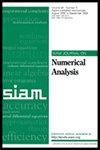参数偏微分方程的化简Krylov基方法
IF 2.9
2区 数学
Q1 MATHEMATICS, APPLIED
引用次数: 0
摘要
SIAM 数值分析期刊》,第 63 卷,第 2 期,第 976-999 页,2025 年 4 月。 摘要。本研究是关于一种用户友好的还原基方法,用于用共轭梯度法、广义最小残差法和双共轭梯度法等预处理 Krylov 子空间方法求解参数偏微分方程族。所提出的方法使用预处理 Krylov 子空间方法对一个参数实例进行高保真离散化,生成还原基子空间的正交基向量。然后在低维 Krylov 子空间中近似求解与参数相关的大规模离散问题。我们证明了当微分算子取决于两个参数系数,且预处理是固定参数下算子的逆时,所提方法的收敛估计值。数值实验表明,只需进行少量的 Krylov 子空间迭代,就能在还原基子空间中同时生成一系列高保真和大规模参数化系统的近似解。这将计算成本降低了几个数量级,因为:(1) 为了构建还原基向量,我们只需解决一个高保真级别的大规模问题;(2) 限制在还原基子空间中的问题族的规模要小得多。本文章由计算机程序翻译,如有差异,请以英文原文为准。
Reduced Krylov Basis Methods for Parametric Partial Differential Equations
SIAM Journal on Numerical Analysis, Volume 63, Issue 2, Page 976-999, April 2025.
Abstract. This work is on a user-friendly reduced basis method for the solution of families of parametric partial differential equations by preconditioned Krylov subspace methods including the conjugate gradient method, generalized minimum residual method, and biconjugate gradient method. The proposed methods use a preconditioned Krylov subspace method for a high-fidelity discretization of one parameter instance to generate orthogonal basis vectors of the reduced basis subspace. Then large-scale discrete parameter-dependent problems are approximately solved in the low-dimensional Krylov subspace. We prove convergence estimates for the proposed method when the differential operator depends on two parameter coefficients and the preconditioner is the inverse of the operator at a fixed parameter. As is shown in numerical experiments, only a small number of Krylov subspace iterations are needed to simultaneously generate approximate solutions of a family of high-fidelity and large-scale parametrized systems in the reduced basis subspace. This reduces the computational cost by orders of magnitude, because (1) to construct the reduced basis vectors, we only solve one large-scale problem in the high-fidelity level; and (2) the family of problems restricted to the reduced basis subspace have much smaller sizes.
Abstract. This work is on a user-friendly reduced basis method for the solution of families of parametric partial differential equations by preconditioned Krylov subspace methods including the conjugate gradient method, generalized minimum residual method, and biconjugate gradient method. The proposed methods use a preconditioned Krylov subspace method for a high-fidelity discretization of one parameter instance to generate orthogonal basis vectors of the reduced basis subspace. Then large-scale discrete parameter-dependent problems are approximately solved in the low-dimensional Krylov subspace. We prove convergence estimates for the proposed method when the differential operator depends on two parameter coefficients and the preconditioner is the inverse of the operator at a fixed parameter. As is shown in numerical experiments, only a small number of Krylov subspace iterations are needed to simultaneously generate approximate solutions of a family of high-fidelity and large-scale parametrized systems in the reduced basis subspace. This reduces the computational cost by orders of magnitude, because (1) to construct the reduced basis vectors, we only solve one large-scale problem in the high-fidelity level; and (2) the family of problems restricted to the reduced basis subspace have much smaller sizes.
求助全文
通过发布文献求助,成功后即可免费获取论文全文。
去求助
来源期刊
CiteScore
4.80
自引率
6.90%
发文量
110
审稿时长
4-8 weeks
期刊介绍:
SIAM Journal on Numerical Analysis (SINUM) contains research articles on the development and analysis of numerical methods. Topics include the rigorous study of convergence of algorithms, their accuracy, their stability, and their computational complexity. Also included are results in mathematical analysis that contribute to algorithm analysis, and computational results that demonstrate algorithm behavior and applicability.

 求助内容:
求助内容: 应助结果提醒方式:
应助结果提醒方式:


